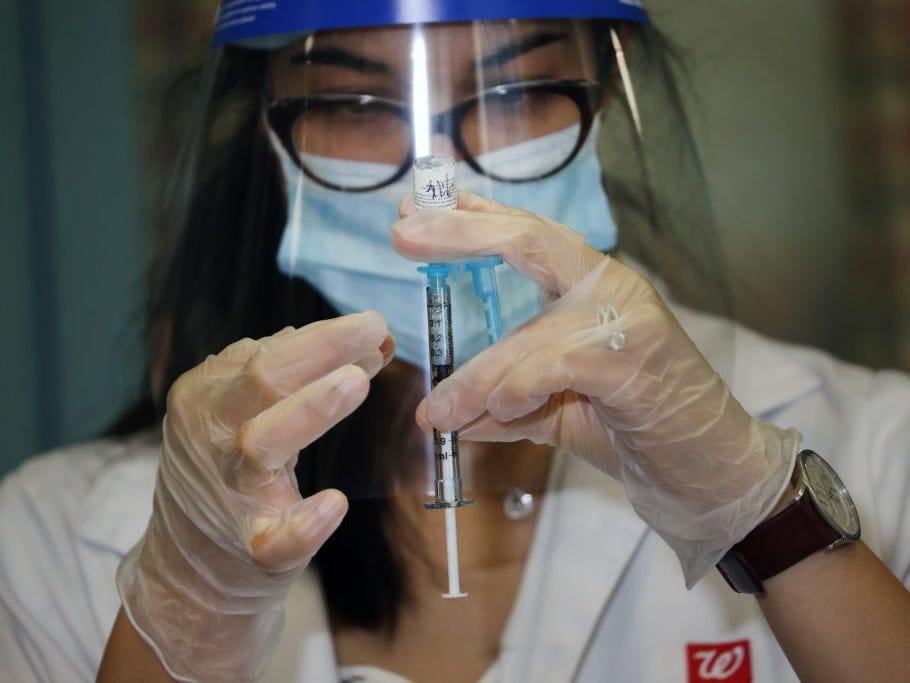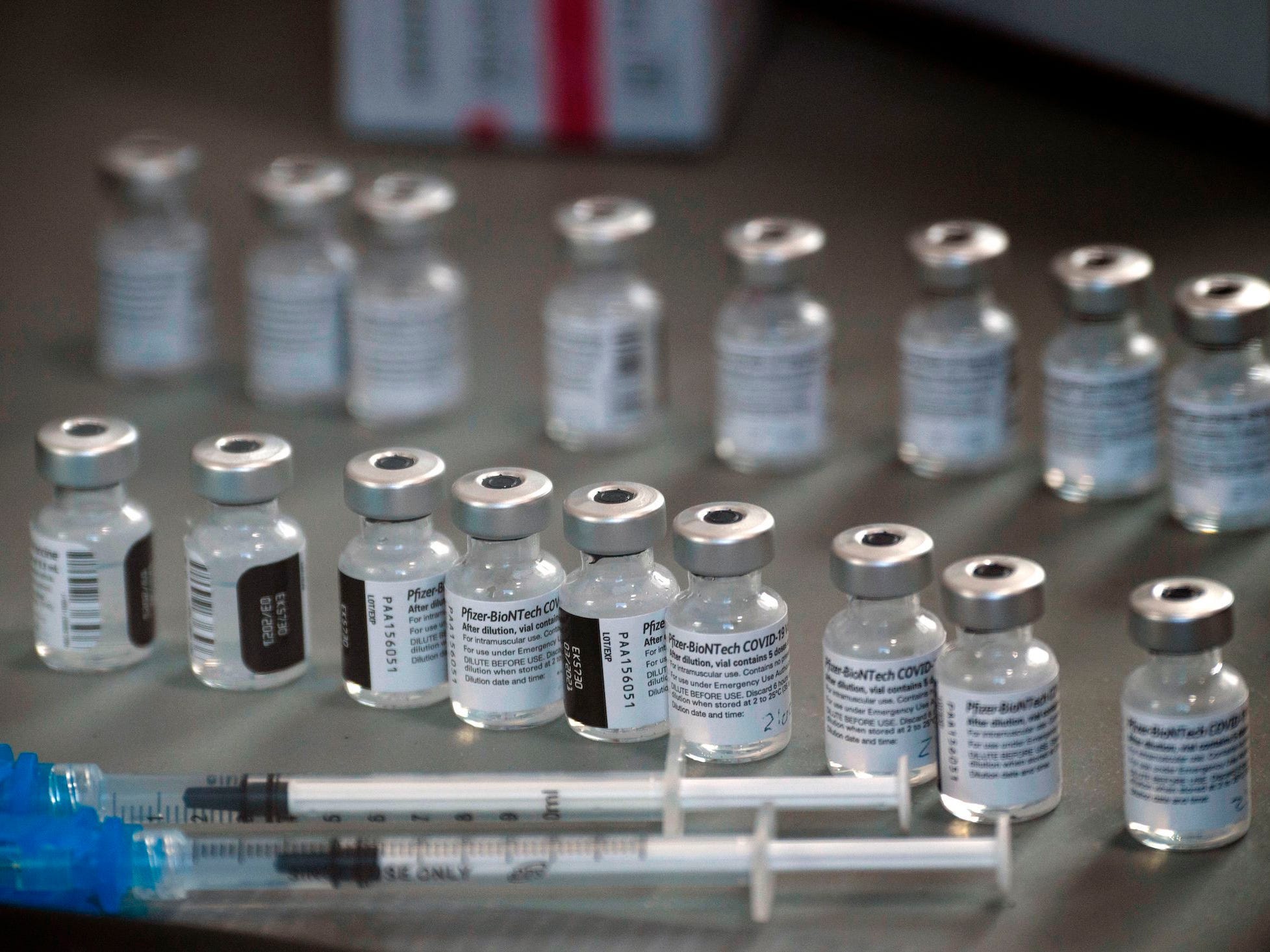
Spencer Platt/Getty Images
- New CDC data shows CVS and Walgreens were responsible for around 70% of US COVID-19 vaccine wastage.
- The data suggests that the two companies wasted more doses than the combined total of most states.
- CVS cited issues with transportation restrictions and limitations on redirecting unused doses as reasons for vaccine wastage.
- Visit Insider's homepage for more stories.
Thousands of COVID-19 vaccine doses are going to waste according to new data from the Centers for Disease Control and Prevention, with the biggest culprits being CVS and Walgreens.
Government data seen by Kaiser Health News noted that as of late March, 182,874 COVID-19 vaccine doses have been wasted. And the two national pharmaceutical chains, which were entrusted with the vaccine rollout in December, were responsible for around 70% of the total wastage, or nearly 128,500 wasted jabs.
Of this number, CVS wasted nearly half of the unusable vaccine doses, while Walgreen's wastage numbers accounted for around 21% of the total.
The data, which was obtained by KHN from public records requests to the CDC and states, US territories, and federal agencies, indicated that the chains had wasted more COVID-19 vaccine doses than most states combined since the start of the vaccine rollout.
The Pfizer vaccine, which was the first vaccine deployed for emergency use in the US, was the most-wasted vaccine, making up 60% of the shots that were thrown away.
CVS, Walgreens, and the CDC did not immediately reply to Insider's request for comment. But in a statement to KHN, CVS spokesperson Michael DeAngelis said doses were wasted due to "issues with transportation restrictions, limitations on redirecting unused doses, and other factors."
CVS and Walgreens were earlier criticized for a slow vaccine rollout to long-term care residents in nursing homes. CBS reported doctors were crying foul and saying that delays and mismanagement on the part of these pharmacy retailers led to the vaccine reaching nursing homes and long-term care facilities over a month behind schedule.
Meanwhile, Walgreens spokesperson Kris Lathan told KHN that its vaccine wastage amounted to less than 0.5% of vaccines the company administered through March 29, adding that the company had administered three million shots in long-term care facilities and some five million shots through the government's retail pharmacy vaccine rollout.
"Our goal has always been ensuring every dose of vaccine is used," Lathan said to KHN. She noted that before a system of scheduled appointments was put in place, Walgreens based the doses it needed on the number of registrations it received, which "minimized excess and reduced over-estimations."
KHN also spoke to CDC spokesperson Kate Fowlie, who said that because the pharmacy retailers had been given the responsibility of administering such a large number of doses, it was unsurprising that they would have contributed to a higher percentage of the overall wastage.
"Though every effort is made to reduce the volume of wastage in a vaccination program, sometimes it's necessary to identify doses as 'waste' to ensure anyone wanting a vaccine can receive it, as well as to ensure patient safety and vaccine effectiveness," Fowlie said to KHN, adding that the CDC is training staff members on how to reduce the waste of vaccine doses wherever possible.
According to Bloomberg's vaccine tracker, 247 million doses of the COVID-19 vaccine have been given so far. An NPR report on April 18 said that more than half of US adults have received their first vaccine dose, with retailers like CVS, Walgreens, Walmart, Rite Aid, and others administering around half these shots.
It should be noted that the CDC's numbers on vaccine wastage account for around 0.00075% of the total number of vaccine doses administered since the beginning of the rollout.
CVS and Walgreens, as well as other retailers who provide the vaccine, do not pay for the vaccine, as the government provides the vaccine for free.
But the vaccines need to be handled with care, as both the Pfizer and Moderna vaccine have a limited shelf life. Pfizer's vaccine vials, which contain several doses per vial, must be used up within six hours. Moderna's must be used within 12 hours.
Chaotic vaccine rollout in December and early January may have contributed to wastage

Patrick Fallon/AFP via Getty Images
States were also responsible for thousands of vaccines being wasted. KHN's requests for comment from states noted that top reasons for vaccine waste included broken syringes, storage errors, and doses leftover in open vials that had to be discarded. There were also larger waste incidents, where freezers malfunctioned, or where workers left vaccine doses out at room temperature for too long.
Data from Texas seen by KHN showed it had the highest number of wasted doses, with 9,229 wasted vaccine doses as of March 26 - making it the third biggest waster of vaccine doses behind CVS and Walgreens.
The US's vaccine rollout got off to a chaotic start in December 2020 and January this year, when the Trump administration left states to figure out their own distribution plans. In January, Biden's Chief of Staff Ron Klain criticized the Trump administration's vaccine rollout, saying that plans to distribute the vaccine into the community "did not really exist" when Biden took office on January 20.
This led to confusion in some states, as NBC reported that elderly people aged 65 and over were lining up overnight for first-come-first-served COVID-19 shots. This distribution snafu happened after Florida Gov. Ron DeSantis opted to ignore federal guidelines and give vaccine priority to senior citizens over essential workers.
Precious doses of the vaccine were also wasted after Wisconsin hospital worker Steven Brandenburg destroyed around 500 doses of the vaccine in January, intentionally removing dozens of vials from a pharmacy refrigerator because he thought the vaccine was unsafe.
KHN spoke to Bruce Y. Lee, a professor of health policy and management at the City University of New York, who said any vaccine waste amounts to "basically throwing (taxpayer) money down the chute."
Lee added that tracking wasted doses would help to identify where bottlenecks might be occurring and adjusting the distribution process where necessary. He noted that early in the vaccine rollout, officials were not assessing where vaccines might be in high demand and setting up sites to fulfill that demand.
"If you think of any business, they're going to determine where the customers are first," he told KHN. "It's not just a matter of loading up the vaccine and going to a place."